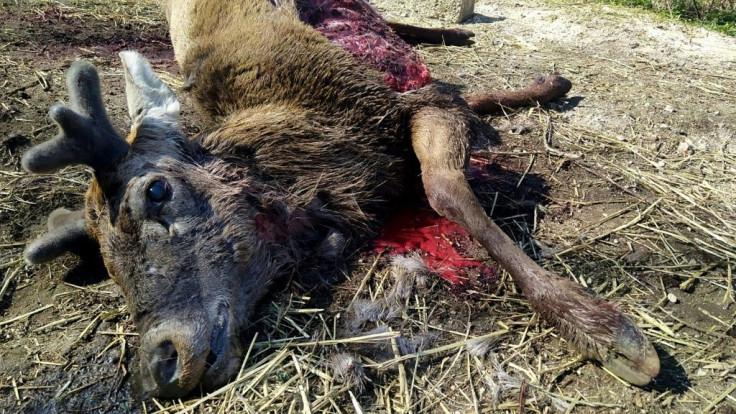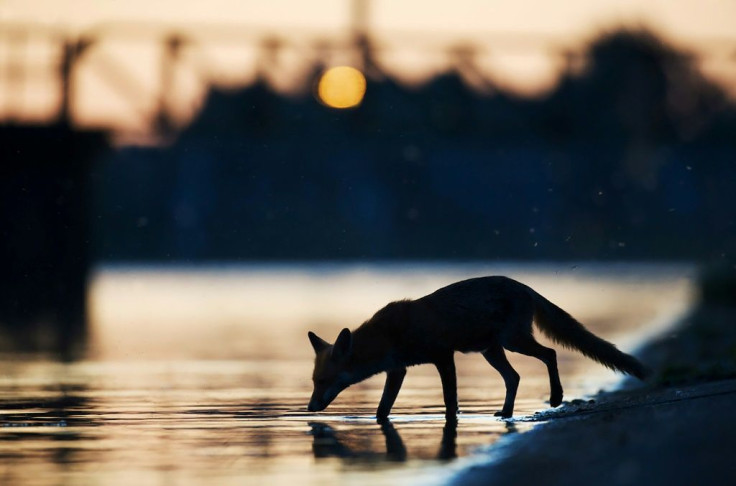In Virus Lockdown, Europe's Predators Regain Turf
The hunter-prey drama took place just outside wildlife enthusiast Ennio Ciccotti's window, in the central Italian town of Scanno.
Four wolves, trailing a herd of red deer, chased them down the road bordering Ciccotti's house, and ran through town, passing across front lawns and shuttered restaurant terraces.
Eventually, the pack snagged one of the deer as it attempted to jump over a high fence.
There was no need to drag it away, the feasting took place on the spot.
Camera traps had captured images of wolves hunting in suburban forests and fields outside Scanno, but seeing them stalk prey in the centre of town was new, said Ciccotti, a volunteer at the wildlife advocacy organisation Salviamo l'Orso.
During Italy's COVID-19 lockdown, which began on March 9, Ciccotti logged at least three instances of wolves hunting deer within the town's confines.
"They just want to eat, so if they are not disturbed by cars, by people, by other human behaviour, they just do what they have to do," he said by phone.

Stories like this have popped up in many locations in recent months.
Across Europe and around the world, stay-at-home orders since early March have allowed some animals to recolonise -- or at least revisit -- urbanised spaces, in which their kind once roamed free.
South Africa's Kruger National Park posted videos on its social media accounts showing lions and hyenas lounging on a golf course in the park's Skukuza Rest Camp.
A wolverine was photographed on an empty beach in Washington State dining on marine animal leftovers, local media reported.
And in Paris, a family of foxes took up residence in Pere Lachaise cemetery -- where Oscar Wilde, Jim Morrison and Edith Piaf, among others, are buried.
Observed by caretakers, the foxes moved in just before France's confinement period began but clearly took advantage of the temporary ban on two-legged creatures, according to Amandine Sanvisens, president of Paris Animaux Zoopolis.
"They lived there two months without seeing a single person," she said, adding that the cemetery's reopening to visitors would likely lead the animals to resume nocturnal behaviour.

While anecdotes abound, biologists are still unsure, however, whether human confinement has significantly altered animal behaviour and believe it could take months, or even years, to find out.
"Movement ecologists are definitely talking about this right now," said Sarah Davidson, a data curator at Movebank, an animal tracking database run by the Max Planck Institute of Animal Behaviour in southern Germany.
"So far we are seeing lots of stories and photos," she noted by email.
"That might be something really exciting, or just the result of people spending more time gazing out the window -- or on Photoshop."
While the return-of-nature narrative may be overblown, there are scientific explanations for why people are spotting more wild animals in urban settings.

For large predators in particular, human confinement has probably been a blessing, according to Liana Zanette, a researcher at Western University in Ontario.
Zanette looks at the impacts of fear on animal behaviour and how the predator-prey relationship influences entire ecosystems, which biologists call the ecology of fear.
Her recent research has shown that, while all animals shun humans, none do so more than large carnivores, such as wolves, cougars and bears.
"Just having us out there on the landscape scares these animals," she said.
In a number of studies, when researchers played recordings of human voices, large predators were more likely to go into hiding than the smaller mammals they hunt.
"The prey animals may not like us, but we give them lots of food and help keep the large carnivore predators away," she said.
"So when we're off the landscape, and the large carnivore predators come back, the prey completely change their behaviour."

Prey will sometimes use the presence of humans as "shields," according to Antonio Di Croce, director of Italy's Monte Genzana wildlife reserve.
But with homo sapiens temporarily confined indoors, other predators feel emboldened to hunt in areas they didn't dare enter before and which prey animals once considered safe, he said.
As human settlements, agriculture and industry encroach deeper into wild habitats, wolves and other predators appear to be adapting to semi-urban environments.
Whether these changes are more perceived than real is a matter of discussion among scientists.
"As time goes by, we will be able to develop a fuller picture of whether we are really seeing big changes in animal behaviour, or whether we are just watching a bit more closely while we are stuck at home wondering what's happening outside," said Sam Williams, a South Africa-based expert on carnivores and a research fellow at Britain's Durham University.
He noted that the COVID confinement has affected different animals in different ways.
While some predators have taken advantage to hunt prey in new areas, others have been on the receiving end of predation due to a rise in poaching.
Some argue that once confinement ends, things will quickly return to the status quo ante.
"Wildlife are very smart," Di Croce said. "When people are coming out again, species that are much more shy are going to go away again."
However, without data, even the most plausible explanations remain speculation, experts caution.
To address that problem, researchers at the International Bio-Logging Society at Scotland's University of St Andrews have collected animal-borne sensor data from more than 60 countries.
"I think that this is going to stretch over a couple of years because we'll probably see people going in and out of confinement," Davidson, at Movebank, said.
The lifting of "strict" confinement periods across Europe may force predators and other large mammals back into hiding.
But conservationists are optimistic that even a brief glimpse of wildlife in our midst will spark interest in how best to conserve it in a warming world.
European nations are currently debating the EU's 2030 Biodiversity Strategy.
"I think that during the confinement, humans realised that they need nature," said Pierre Dubreuil, head of the French Office of Biodiversity.
"Now, the next step is to understand how we are going to cohabitate with it."
In some ways, the confinement highlights trends already under way across Europe, according to Frans Schepers, the cofounder of Rewilding Europe, which pushes for the reintroduction of wild animals.
Large carnivores were once ubiquitous in Europe but had nearly disappeared by the end of World War II, he said.
But thanks to concerted conservation efforts, Europe's four major large predators -- brown bears, lynx, wolverines and grey wolves -- have all seen a resurgence.
This is true even in unprotected zones, according to a study led by Swedish researcher Guillaume Chapron, who counts more than 17,000 bears and 12,000 wolves across the continent.
The resurgence of large predators in Europe and elsewhere will have a positive impact on biodiversity, rippling down the food chain, Zanette noted.
"It shows you the incredible resilience of nature -- it just bounces back if we allow it to," Schepers said.
© Copyright AFP 2024. All rights reserved.




















